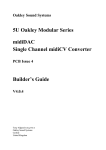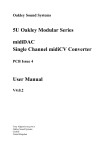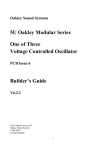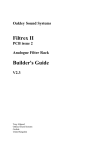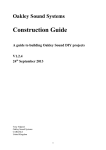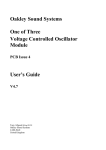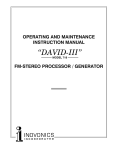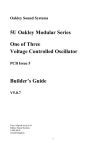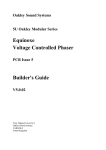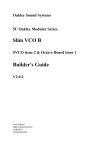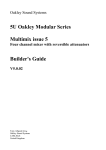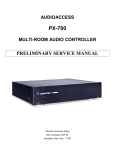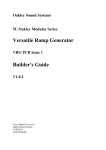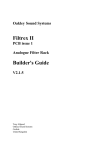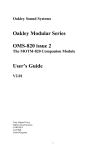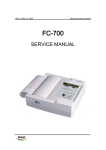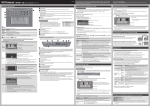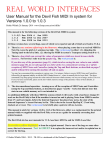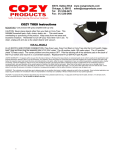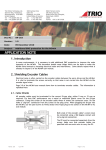Download midiDAC User Manual and Builders Guide
Transcript
Oakley Sound Systems midiDAC Issue 3 Single Channel midi-CV Convertor User Manual and Builders Guide V3.5.1 Tony Allgood B.Eng PGCE Oakley Sound Systems Carlisle United Kingdom This is the issue 3 midiDAC in a natural finish Schaeffer panel. Note the new rounded corners. The toggle switches are APEM flat blade toggle switches available from Farnell. The round LED holders come from Maplin, whilst the knobs are the Rapid's 'matt black control knobs' for 1/4” fitting. 2 Introduction For general information on how to build our modules, including circuit board population, mounting front panel components and making up board interconnects please see our generic Construction Guide at the project webpage or http://www.oakleysound.com/construct.pdf. The issue 3 midiDAC is a single channel midi to analogue convertor. This project is a joint development between Oakley Sound and Trevor Page. Trevor wrote the firmware for the processor used in this project. The midiDAC is designed to drive any 1V/octave synthesiser or modular system. Let us first have a look at the different outputs available. Gate: +5V gate or +15V gate Pitch CV: 127 steps of 12 bit accurate pitch voltage conforming to 1V/octave (trimmable). Pitch bend may be added to this signal, and the maximum bend interval (up to one octave) can be adjusted from a front panel control. Velocity: 0 to 10V proportional to midi note on velocity. Pitch Bend: -5V to +5V proportional to pitch bend wheel position. 0V corresponds to a centred wheel. Modulation: 0 to 10V proportional to modulation wheel position. Aftertouch: 0 to 10V proportional to midi channel aftertouch. CC # 100: 0 to 10V proportional to midi controller number 100. Legato: This signal goes to +5V when two notes are played at the same time. This can allow slides to be activated at will; TB303 style. An optional external switch may be used to override the automatic activation of slide. Slide may be turned off by transmitting the standard midi glide/slide command. The outputs are available on two sets of 4-way 0.1" connectors at the top of the board. Also featured is a 3-way header to directly feed the Oakley ‘CV-velocity-gate’ buss on the Dizzy board. The design also features a midi thru circuit which is greatly improved on the previous issue midiDAC designs. The processor used in this project is a PIC16F628 running at 4 MHz. Although this PIC has a lower clock speed than issue 1 and 2 midiDAC boards, its onboard UART allows it to process midi data far more efficiently. Please note: this product does not support the use of V/Hz or linear VCOs. These are found on some Yamaha and Korg analogue products, and just one Roland, the SH-2000. 3 Other Features There is a note stack within the firmware to allow the midiDAC to remember notes pressed. Thus if two or more notes are pressed at the same time, the oldest notes will be remembered so that if the more recent notes are removed the pitch will return to the still pressed older notes. The midiDAC also includes a TB303 style slide circuit. This can be turned either by engaging a switch, or by playing two notes at once. The pitch will glide up or down to the most recently pressed note. A pot can control the speed of the slide. Note retriggering is an option that can be changed on the fly. A simple switch or link can be used to select whether it is on or off. Ordinarily, when a note is pressed the gate always goes high. However, if a second note is pressed while another is still held down, the pitch CV will change but the gate remains high. The envelope generators on your synth will not retrigger. This is typical of Moog synthesisers. It can be useful. The 'Retriggering' mode allows the gate to drop momentarily when any new note note is pressed if there is a note already down. Thus, when the pitch CV changes, the envelopes will be retriggered, just like a normal note. This allows fast keyboard runs to be easily achieved. The new suggested panel layout incorporates both the glide and re-trigger switches. The midiDAC features a built in midi THRU port. This essentially produces a copy of the midi input signal which can be then fed to another midi unit. Previous issues of the midiDAC board used THRU drivers which added appreciable delays to the midi signal passing through it. These delays would build up if the midiDAC was used to drive another midiDAC. Using two older style midiDACs in series was probably alright, but driving a third from the THRU output of the second almost certainly did not work. The issue three midiDAC has a much faster THRU circuit. Both the opto isolator and the THRU buffer are high speed devices so longer midi chains can be tolerated. Even so, long midi chains are generally to be avoided in any system. If you intend to use an older issue midiDAC with your new midiDAC in the same chain, then put the older one last in the chain. Power Requirements The module requires a split supply of +/-15V at around +40mA and -30mA. Two sets of 0V or ground are required. This is to keep the analogue ground as distinct as possible from the noisier digital ground. Both grounds are required for correct operation of the midiDAC. They must be both connected to the power supply’s star point or common ground bus. If you have a complete Oakley Modular System, it is recommended that you do not directly connect the midiDAC’s power supply to the same power bus as the modules. That means don’t connect it to the Dizzy board. This is because pin 3 of the power inlet on the midiDAC 4 board is used as the digital ground and not the chassis ground as on other Oakley modules. Connection to the Dizzy distribution system will not damage the midiDAC module, but it may introduce unwanted noise on the power lines. Therefore please connect the midiDAC directly to the power supply output pins. This will, of course, be still connected to the same power rails as the modules but the path to the power supply will be separate and distinct. To summarise this: One has to connect pin 1 of the PSU header to the positive output of your power supply. Connect pin 4 to the negative output of the power supply. Connect both pins 2 and 3 to the ground of the power supply. Use two separate wires for these ground connections, taking each wire back to the supply and connecting them together at the ground tag on the supply. For connection with a MOTM power supply, we recommend that you connect the midiDAC to the distribution board on the MOTM supply directly. That is, not to a daisy chained distribution board far away from the MOTM supply. The new issue midiDAC features some comprehensive protection mechanisms to prevent problem with the circuitry should the power supply fail. Earlier issues of the midiDAC were prone to failure of the 4066 and sometimes the DAC chips if the positive rail collapsed whilst still applying negative power. This unlikely event may have been triggered by inappropriate use of the power supplies or indeed spurious power up problems. The midiDAC-3 has been designed to withstand this sort of abuse. The Printed Circuit Board The PCB has been designed to fit within a 2U across MOTM style modular face plate. The size of the board is slightly smaller than older issues at 13.3 cm high and 11.1 cm deep. It has three PCB mounted pots to facilitate TUNE, BEND DEPTH and SLIDE RATE. The pots are spaced at the standard Oakley and MOTM spacing of 1.625". Midi channel is selected by four lines in ‘traditional’ binary fashion. Thus midi channel can be switched by either onboard DIP switches or links, or by a 16 position rotary HEX switch mounted on the front panel. I tend not to change midi channel once I have built the unit, so I use DIP switches only. Because of this, there is no midi channel selector on the suggested front panel layout. However, the board is equipped to take a 0.1” header to allow simple connection to a rotary HEX switch. The issue 3 PCB is double sided, has through plated holes, solder mask both sides and has full component legending. All boards sold by us are Pb free and RoHS compliant. Be aware that some of the resistors have their legending underneath the component. So once the resistor is in place it does make it difficult to identify the part’s name. This had to be done to reduce the board surface area. However, all parts are labelled in a systematic fashion so that the smaller numbers are furthest left. Power is admitted to the board via 0.156" Molex connector, just like the MOTM modules. (see section above) 5 The PCB has four mounting holes, one in each corner. However, using the midiDAC with the recommended pots and brackets, will give you sufficient support without the need for additional mounting hardware. The pots are Spectrol 248 series or BI TT equivalents, supplied by Farnell, CPC and Rapid Electronics here in the UK. The pot mounting brackets are specially made for the Oakley modular system and are available only from us. Circuit Description The midi data is electrically isolated by U7, a high speed logic output opto-coupler. The output of U3 is pulled up via R44 and drives two circuits. One is the PIC, the processing engine of the midi interface. The other is the midi THRU circuit. The latter is a circuit that simply copies the data seen on the MIDI input port and presents it to the midi thru output socket if one is fitted. U6 is a simple logic inverter gate, and two of these inverting gates in series produce a buffered version of the opto’s output signal. Although U6 hardly affects the signal at all, it does give it a current boost allowing it to drive the midi lines via the standard 220R resistors. Notice the midi out connector requires the middle pin to be grounded for shielding purposes. This is not allowed by the midi specification for the midi input socket, so grounding should only be provided on the thru socket. The heart of the midiDAC is a preprogrammed PIC16F628. This is where Trevor’s firmware is located. X1, a 4 MHz crystal provides the necessary timing for the PIC’s internal oscillator. For more details on the operating system of the PIC see the ‘Firmware Data’ section. Three of the PIC’s output lines directly drive a 12-bit DAC, U9. The DAC is driven serially, and this is different to the old issue tbDAC where we used a parallel loading DAC. Although, the DAC is a 12 bit device we actually only use 7 bits. The other 5 bits of data are held low at the appropriate time in serial data stream. Why use only the top seven? Firstly, midi data is arranged, in the main, in blocks of seven bits. For example there are only 127 notes that a normal midi keyboard can send out. Secondly, the PIC does not perform any CV scaling or tuning. This is sometimes used on other midi-CV convertors to generate ADSR and pitch bend information that is then merged in the digital domain to the pitch data. 14 or 16 bit DACs are required for this. We do all of our CV processing in analogue hardware. Thus slide time and pitch bend can be simply controlled by a pot or a trimmer. So why not use an eight bit DAC? 8-bits, although it gives us 256 steps to play with, the accuracy of the steps is only plus and minus 1/512 of the highest output voltage of the DAC. That is an error of 0.2%. This may not sound much, but it does matter. In musical terms, this means that a semitone between one pair of adjacent notes, will be different to a semitone between another pair. Tim Orr, of EMS fame, reckoned that at least 10-bit accuracy was required for users not to hear any difference in the steps. I have chosen to use 12-bits, because 12 bit DACs are cheapish and easily available. Errors in a good 12-bit DAC will be negligible compared to VCO tracking errors. 6 The MAX551 is a current output multiplying DAC. This means two other things are needed to get it to convert digital data to an analogue voltage. Firstly, you need a very accurate reference voltage. This will set the maximum output voltage that the DAC circuit will supply. For the midiDAC the reference comes from a reference voltage chip, U3. This generates a stable 5.00V at its output. A multiplying DAC will invert the reference signal applied at pin 19. So to get a positive output from our DAC, we have invert the 5V reference with U2 (pins 1, 2, 3). This is a precision op-amp, configured as an inverting amplifier to produce the required -5V. The second item the DAC needs to create a voltage output, is a current to voltage convertor. This is strapped onto the output of the DAC, and in practice it simply consists of a single opamp. This is U8. It needs to be accurate, have low drift over time and be fast settling. I have chosen an AD712 by Analog Devices. C19 provides stability. With a -5V reference the output of the current to voltage convertor is a maximum of +5V. We need a higher level of signal than this, so we amplify the signal by exactly two. This is done with the other half of U8, which is configured as a non inverting amplifier of gain two. Notice the 0.1% tolerance resistors to set the gain. This is because we need to have accuracy here so that our pitch bend circuit works correctly. The alert reader may well point out that we could have obtained a full scale output of 10V by providing the DAC with a -10V reference. This is true, but the datasheet for the MAX551 hints that best performance is obtained with a -5V reference. C13 and R42 allows the op-amp to drive the high capacitance load of the sample and hold circuits without DC error or instability. D7 is there to protect the demultiplexer chip, U14, from any spurious negative voltages that may occur on power up. Notice, that the op-amps and reference have separate grounds to the digital parts of the circuit. They have a different symbol on the circuit diagram like an upside down triangle. This is called 'analogue ground’. It is at the same potential as digital ground and both are connected at the star point within your system’s power supply. The theory is that any current spikes on the digital ground do not manifest themselves as voltage fluctuations on the sensitive analogue ground. The DAC’s output is constantly varying. All six CV outputs, which are controlled by a stream of 12-bit data from the PIC, are represented by this fluctuating output. Each output has its own time slot and this gives rise to a waveform that has six distinct sections that continuously repeat, once every 4000th every second. The demultiplexer based around U14 will direct each of these six outputs to its own output section. U14 is like an electrically controlled rotary switch. The PIC controls this switch via the level shifting chip, U15. The demultiplexor needs a 15V logic signal whilst the PIC only provides +5V. U15 is a one chip solution to this and converts the low level logic from the PIC into the high level logic needed to drive the 4051. The switching is tied in directly to match the output of the DAC so that the correct order of the time slotted output goes to the correct destination. The PIC also only enables U14 in such a way so as to allow the output of U8 to settle accurately before allowing it through to the next stage. 7 Each output section is called a ‘sample and hold’, although to be strict the demultiplexer also forms part of the sample and hold. The capacitor in each S/H holds or stores the voltage that is briefly connected to it. The op-amp that is connected to it, allows this voltage to be ‘sniffed’ without effecting the actual value. The op-amps are connected as voltage followers or buffers. They have gain of 1. Thus, the sampled voltage on the hold capacitors can be found at the output of each op-amp. Note, that pitch CV and pitch bend use low offset FET op-amps, U12, for accurate pitch control. Note that not all of the eight outputs from the demultiplexor are connected to S/H circuits. The PIC only processes six midi controllers so the other two outputs are unused. The pitch and pitch bend CV are processed further by the midiDAC. This circuitry is seen on page two of the schematics. The pitch CV is sent to the slide circuit. This circuit is based heavily on the slide circuit from the TB303, and, of course, the Oakley 3031. When the slide is not enabled, the first portion of the analogue switch, U5, is off. The pitch CV is then passed through the slide pot straight to the op-amp buffer, U4 (pins 1, 2, 3). The resistance of the slide pot has no effect on the CV because the input impedance of the buffer is very, very high. The second portion of U5 is on, and the capacitor, C2 is charged up to the CV voltage. Slide is activated, either by the PIC via the SLD logic line, or manually via the ‘SLID’ header being shorted by the SLIDE switch. This then causes the two sections of U5 swap states. The pitch CV now has to charge C2, via the slide pot, every time the CV changes. The higher the resistance of the slide pot, the longer it takes to charge up or down. The slide signal from the PIC also drives the ‘legato’ LED via U6. The LED is connected to a 2 pin header on the PCB, labelled ‘LEG’. The pitch bend CV varies from 0 to 10V depending on the status of the pitch bend controller. For normal use, we require the pitch bend to go from -5V to +5V, with 0V representing the pitch bend wheel centralised. To do this we must subtract exactly 5V from our pitch bend CV signal. This is done with a simple summing amplifier based around U2 (pins 5, 6, 7). This adds the -5V reference voltage to the pitch CV. Since the pitch CV is centralised at +5V, when we add these two voltages together, they cancel. However, a positive (upwards) bend produces a negative voltage so we must invert the summed output with another op-amp circuit. This is based around U4 (pins 5, 6,7) and features capacitive loading protection via R28 and C8. The output of this circuit goes to the Pitch bend output socket and the Pitch Bend depth pot. The Pitch bend depth pot allows a fraction of the pitch bend CV to be added to the pitch CV. Thus wiggling the pitch bender will automatically control the pitch of any connected VCOs. The circuitry based around both halves of U1 add the pitch bend CV to the pitch CV and to allow fine tuning of the VCO pitch. Note the use of 0.1% resistors in the summing circuit. If ordinary 5% resistors were used here, it is likely that the -5V and the +5V signals would not be exactly cancelled. This would result in a small error voltage, ie. non zero, at the pitch bend output. 8 Two forms of setting the initial pitch CV are provided. One is the TUNE pot mounted on the front of the panel. The other is INIT, which is a multiturn trimmer that will allow precise setting of the initial pitch CV, and thus aid centralising the TUNE pot’s range. In this version of the midiDAC, the pot and trimmer take their end voltages from the +5V and -5V reference voltages. This should lead to greater stability of the CV output even if the power supplies change slightly. There are 12 notes in one octave, and a jump of 1V must represent one octave when applied to a VCO. Thus, 1/12 = 0.083333V or 83.33mV per semitone step with a perfect DAC. There are 127 notes in the midi scale, so the highest voltage must be 127 x 83.3mV = 10.58V. With a -5V reference the smallest step our DAC will increment is only 78.7mV, so we need to amplify up the pitch CV by around 1.06 to get the desired 83.3mV stepping. This is done in the first summing circuit. The V/OCT trimmer allows to fine tune this gain to match your midiDAC to your VCO’s sensitivity. The PIC generates the gate signal directly from on if its outputs. It actually an inverted gate to allow the main gate output to be generated by a single NPN transistor, Q2. The collector may be wired to either the +5V or the +15V rail depending on the size of the gate signal required. The GATE LED is connected to a 2 pin header on the PCB, labelled ‘Gate’. Its driven by a spare gate within the inverter chip, U6. Note that if you use the suggested layout, the LED may be mounted straight into the board for a tidy appearance. U11 provides the regulated +5V supply for the PIC and DAC. R54 and C16 provide power supply decoupling from the higher +15V rail. The four ferrites on the board, L1 to 4, act as high frequency suppression to remove any digital noise from the power supply. The level shifting chip, U15 and the demultiplexor, U14 also have their own decoupled and filtered supply. This is to prevent the fast switching pulses generated by U15 from affecting the power supplies in the modular. Any digital noise would be heard as audible whining from any audio output. PIC Firmware Data Version 2.2 The PIC could in theory generate 8 output control ‘voltages’ when used with a single DAC and 8-channel demultiplexer. However, we only use six of them in this version of the midiDAC and tbDAC firmware: Output CV generated 1 2 3 4 5 6 7 8 Pitch CV Modulation Wheel Note on velocity Pitch bender Aftertouch CC 100 Reserved Reserved 9 The PIC also generates two digital type signals direct from its own ports. These are gate and slide. The former goes low when any note on is received on the selected midi channel and will go high when a note off, or key velocity zero, is received. It will briefly blip high in the case of ‘legato mode’ off if a second (or third, etc.) note is pressed whilst others are still held down. The Slide output will go low if more than one note is active on the selected midi channel. The slide will go high if there are no overlapping notes. For both logic outputs, it is expected that the PIC will drive NPN inverting stages. This is to protect the PIC from improper connections to the true slide and gate outputs. It also provides the facility to level shift upwards very easily. A third logic output is also available that can drive a midi active LED which is unused in the midiDAC-3. This output goes low for 500mS if any valid midi data is present on the midi port. Midi Channel selection Midi channel is selected by four lines which must be either floating or be grounded. The simplest way to set midi channel is with a 4-way DIP switch which shorts the data line to ground. 0 is switch closed (ON) and 1 is switch open (OFF). Binary codes are being read pin 4 to pin 1. Pin 4 is MSB, pin 1 is LSB. Code 0000 0001 0010 0011 0100 0101 0110 0111 1000 1001 1010 1011 1100 1101 1110 1111 Midi Channel 1 2 3 4 5 6 7 8 9 10 11 12 13 14 15 16 For example, to set midi channel 3, set the DIP switch to 0010. That is, from positions 1 to 4: 1- on, 2- off, 3- on, 4- on. 10 Gate Trigger Modes The midiDAC allows the selection of two gate trigger modes via the ‘Legato mode’ switch. This is marked on the new PCB as ‘RE-TRIG’. You can connect a simple SPST switch to this or a simple jumper. The setting of this switch/jumper determines how the gate signal responds to overlapping notes. Closing this switch, or fitting the jumper, enables multiple gate triggering for legato playing. This is the re-trig option. The gate signal is taken briefly low at the start of a new note, even if the fingers haven’t left the keyboard from the previous note. With the switch open, or leaving the position blank, the gate does not retrigger for overlapping notes. This is the classic analogue keyboard method and more suitable for those TB303 slides. Legato Mode may also be enabled or disabled via the Legato Footswitch MIDI messages. If these messages are to be used, the Legato Mode switch on the tbDAC unit should remain in the off position. midiDAC Implementation of MIDI Controllers The following table summarises the MIDI controllers supported by the midiDAC firmware. Hex Dec Midi Controller Definition Implementation on the midiDAC 41h 65 Portamento (Slide) 44h 68 Legato Footswitch 78h 120 All Sound Off 79h 121 Reset All Controllers 7Bh 123 All Notes Off 7Ch 124 Omni Mode Off 7Dh 125 Omni Mode On 7Eh 7Fh 126 127 Poly Mode Off Poly Mode On On / Off Switches the portamento (slide) function Controls the gate retrigger mode. 0 to 63 = off, 64 to 127 = on. Silences all notes & clears accent/gate/slide. Data byte = 0 for this controller. Centres Pitch Wheel and zeroes various controllers. Data byte = 0 for this controller. Silences all notes & clears accent/gate/slide. Data byte=0 for this controller. Unit responds only to selected MIDI channel. Data byte=0 for this controller.* Unit responds to any MIDI channel. Data byte=0 for this controller.* All notes cleared* All notes cleared* 11 * In accordance with MMA specifications, all notes are cleared when these controller messages are received. Note Priority The midiDAC firmware uses last note priority. That is, it will assign the pitch CV to the last note to be held. However, all 'overlapped' notes are still retained in memory and are reactivated in order should the most recent notes to be held be released. Firmware Bugs As far as we know there are no known issues with the software in its current state. The design has been tested and used extensively and we have not found any problems. The midiDAC has proved very rugged and is very reliable. However, there was one report that auxiliary CV outputs were unstable when the selected midi channel was between 9 and 16 and when the midi buss was very busy. We were unable to reproduce this so it may have been poorly performing midi buss on the user's system. But it may have been that we were 'lucky' in not being able to replicate exactly the fault conditions. In any case, if you do notice any problems with the way the midiDAC handles midi data, please do let me know. Copyright Notice Please note: No permission is granted to copy in anyway, or alter, the PIC firmware provided on the tbDAC PIC. The PIC is copy protected and we will not tolerate any attempt at bypassing this protection. A lot of hard work has gone into the design of the firmware, please do not steal it from us. The firmware is not available separately, although pre-preprogrammed PICs may be supplied to interested parties wanting to develop midi-CV interfaces for their musical projects. Please contact me at Oakley Sound for more information. 12 Components For general information regarding where to get parts and suggested part numbers please see our useful Parts Guide at the project webpage or http://www.oakleysound.com/parts.pdf. Some special considerations for this project Many of the resistors are 1/4W 5% or better types. Although there are some 1% and 0.1% resistors listed. I would generally recommend 1% metal film types throughout except where 0.1% are specified. The 10K 0.1% resistors are sold by Rapid at pt. number: 63-1448. The most excellent MAX551ACPA is available from Maxim direct, although they may have minimum order quantities in your country. Because of this, the part is available through us for a very reasonable price. All the electrolytic capacitors should be radially mounted. The working voltage for the 1uF and 2.2uF capacitors should be either 50V or 63V. The other values should have a working voltage of 25V or 35V to keep the physical size down. The pitch spacing of the polyester capacitors is 5mm (0.2”). I use metalised polyester film types. These come in little plastic boxes with legs that stick out of the bottom. Try to get ones with operating voltages of 63V or 100V. C2 is specified as a 1.5uF, 63V (or 50V) polyester capacitor. Polyester capacitors should be used in this position to ensure tuning stability at longer glide times. The midi channel selection is performed by a 4 way DIP switch. These are available in many different types, but get the ones with 0.3” spacing between the rows. This is the most common type anyway. Avoid the piano key style ones, since they can be very confusing... er, which way is on? Fit the switches so that switch one is towards the bottom of the board. LSB is then switch one. Some of the op-amps are not your ordinary TL072 type. There is a good reason to use the ones specified. The OPA2277PA is a low offset bipolar op-amp. It may be substituted with a LT1013. Both these parts will give less pitch drift. The AD712JN is a low offset FET op-amp. This has a high impedance, low bias current and high speed and is well suited for the DAC output amplifier. The LF412 is a fairly standard dual FET op-amp with a good performance in sample and hold applications. The HEF4104BP is a four channel low to high level shifter. Its available from Farnell and also from Oakley Modular. The REF02 is a 5V reference. Get the cheapest one in DIL form on offer. All but one of the ICs are dual in line (DIL or DIP) packages. These are generally, but not always, suffixed with a CP or a CN in their part numbers. For example; TL074CN. Do not use SMD, SM or surface mount packages. 13 One of the ICs is a three pin TO92 style package. This is the 78L05 which is a 5V 100mA regulator chip. The multiturn trimmers are the ones that have the adjustment on the top of the box. Spectrol and Bourns make these. Some types are 22 turns, while others are 25 turns. Either will do. They should have three pins that are in a line at 0.1” pitch. Don’t chose the 10-turn ones with the adjustment on the end, they won’t fit on the PCB. The crystal is a 4MHz type. Low profile ones are now available and these can be used if you can get them. The usual types will fit no problem. The PCB has been laid out to accept 0.1” headers for all the interconnects except for the power supply. Pin 1 is depicted by the square pin. The three way 0.1” header is for use with the Dizzy normalisation scheme. See the Dizzy User Guide for more information. 14 Parts List For general information regarding where to get parts and suggested part numbers please see our useful Parts Guide at the project webpage or http://www.oakleysound.com/parts.pdf. The components are grouped into values, the order of the component names is of no particular consequence. A quick note on European part descriptions. R is shorthand for ohm. K is shorthand for kiloohm. R is shorthand for ohm. So 22R is 22 ohm, 1K5 is 1,500 ohms or 1.5 kilohms. For capacitors: 1uF = one microfarad = 1000nF = one thousand nanofarad. To prevent loss of the small ‘.’ as the decimal point, a convention of inserting the unit in its place is used. eg. 4R7 is a 4.7 ohm, 4K7 is a 4700 ohm resistor, 6n8 is a 6.8 nF capacitor. Resistors All values are 5% carbon or metal film ¼ W or better except those listed as 1% or 0.1%. These must be 1% metal film and 0.1% metal film respectively. 100K 100R 10K 10K, 1% 10K, 0.1% 11K 1K 220R 22K, 1% 22R 2K2 33K, 1% 390K, 1% 3K3 47K 4K7 680R 75R R16, R18 R54, R56 R30, R29, R25, R37 R21, R7, R4, R22 R45, R24, R26, R40 R17 R10, R53, R42, R44, R48, R34, R49, R47, R50 R38, R52, R14 R15, R9 R55 R51, R11 R19 R5 R27 R1, R6, R13, R36 R32, R31, R8, R23, R46, R43, R41, R39 R3, R2, R12 R28, R20 For +15V gate output: Make R33 a 10K resistor and omit R35. For +5V gate output (recommended): Make R35 a 10K resistor and omit R33 Trimmers 2K Multiturn cermet 100K Multiturn cermet V/OCT INIT 15 Pots 50K linear Spectrol 248 100K log Spectrol 248 TUNE, BEND SLIDE Capacitors 100nF axial multilayer ceramic 10nF 100V polyester film 18pF low-K ceramic plate 1uF, 63V electrolytic 1u5, 63V polyester 22uF, 25V electrolytic 2u2, 63V electrolytic 33pF low-K ceramic plate 47uF, 25V electrolytic C23, C11, C36, C32, C3, C30, C15, C4, C6, C5, C12, C21, C20 C1, C31, C27, C28, C34, C29, C33 C25, C26, C19 C10 C2 C35 C9, C22, C14, C24, C17, C18 C13, C8, C7 C16 Discrete Semiconductors 1N4001 silicon diode 1N4148 signal diode BAT42 schottky diode BC550 small signal NPN transistor 5mm LED of any colour D9, D10, D8, D3 D5, D6 D7, D2, D4 Q2, Q1 GATE, LEG D1 is not fitted. Integrated Circuits 16F628-04 midiDAC PIC CD4051B 1-8 mpx CD4066B analogue switch HEF4104BP level shifter 6N137 optocoupler 74HC04 Hex invertor 78L05 +5V regulator AD712 Dual FET op-amp LF412 Dual FET op-amp MAX551ACPA 12-bit DAC OPA2277 REF-02 Precision 5V reference TL084 Quad FET op-amp U10 U14 U5 U15 U7 U6 U11 U8 U4, U12 U9 U1, U2 U3 U13 16 Connectors 4-way Molex 0.156” header 4-way 0.1” header and socket 3-way 0.1” header and socket 2-way 0.1” header and socket 1off (PSU) 2 off (CN1, CN2) 2 off (midi thru and Dizzy Bus) 1 off (midi in) Miscellaneous 4MHz Crystal (parallel resonant) FERRITE LED clips Toggle switches 4-way DIP switch Knobs 1/4” sockets 5-pin midi sockets X1 L1, L2, L3, L4 Two off, colours to suit choice of LEDs Two off, one for Trigger and one for Slide One off Three off Eight off Two off You may well want to use sockets for the ICs. I would recommend low profile turned pin types as these are the most reliable. You need eight 8-pin DIL, three 14-pin DIL, two 16-pin DIL, and one 18-pin DIL. 17 Connections How you connect your midiDAC very much depends on where you are going to use the midiDAC. You may already have an idea of how you are going to connect your midiDAC to your chosen system. For those building the standard Oakley midiDAC modular panel I will give the wiring instructions in detail. The suggested layout uses eight sockets, and wiring them up is straightforward enough. Use multistrand hook up wire to connect each socket’s signal lug to the relevant pad on the PCB. Keep your wires short but not too short and use as many different colour wires as you can. There is no need to use screened cable for such short runs. If you have used Switchcraft 112 sockets you will see that they have three connections. One is the earth lug or ground tag. The second is the signal tag which will be connected to the tip of the jack plug when it is inserted. The third tag is the normalised tag, or NC (normally closed) lug. The NC lug is internally connected to the signal tag when a jack is not connected. This connection is automatically broken when you insert a jack. The midiDAC uses only the signal lugs on each connector. The other two lugs are not used at all in the suggested layout. The PCB has been laid out to accommodate 0.1” headers for all interconnects. This is very useful for taking the board in and out for servicing. However, for a panel fitting into a modular synth, there is no reason why you can’t solder wires directly into the holes. Socket name Header Pin Pitch Velocity Bender Modulation Aftertouch CC Gate Slide CN1 CN1 CN2 CN2 CN2 CN2 CN1 CN1 1 2 4 2 1 3 3 4 The earth lugs of each socket are left floating as a solid ground to the module is already provided in the form of the power supply ground lead(s). This means that no earth loops will occur because of inserted patch leads. However, depending on your own system, it may be necessary to connect each output jack’s ground tag to the AGND on the input power connector on the PCB. You can connect all the ground lugs together with a piece of uninsulated wire, and have one piece of insulated wire going back to the AGND pin. But remember a modular panel will probably be metal, and may well be earthed through the panel housing. Your best bet is to leave the lugs unconnected at first, and only connect them to ground if you get problems. My ready made units have the grounding lugs unconnected. All other Oakley modules have two grounds, one for the chassis and jack screening, the other for the power supply to the module. The midiDAC couldn’t use this method with just a four way plug. Here, we have AGND and DGND, both must go back to the power supply 18 separately. It is preferential to use a separate 4-way power lead to the midiDAC that comes straight from the power supply and not via any other module. The ideal modular would have three grounds, a chassis or safety ground, a clean power supply ground (AGND) and a dirty power supply ground (DGND). To remain compatible with the MOTM system, I have stuck with just two grounds. If you are fitting your midiDAC into a single box with some other analogue synth circuitry, the connect the two midiDAC grounds to the central power supply star point. You do not need any further connections to ground from or to the midiDAC. The two LEDs should be able to be wired directly to the board without using additional lengths of hook up wire. Pin 1, the square pad, should go to the anode of the LED. And pin 2 to the cathode. If you have used bipolar LEDs you can wire these in any way around they’ll still work fine. You will have to bend the legs of the LED towards to board. This should be done close to the body of the LED and be done carefully so as not to break the resin casing of the device. Use a pair of fine nosed pliers to do the job. A LED clip should be used to secure the LED to the panel. The Cliplite range from Maplin, and others, are perfect for this job and offer a smart finish. Alternatively the integrated Lumex parts come with their own casing and but should still fit into the PCB directly. The two switches will now be wired to the panel. These require short lengths of wire to connect them to the board. A standard SPDT switch has three solder tags. You will need to connect the two pads on the board to the top two tags on the relevant switch. The lower tag on each switch is left unconnected. It doesn’t matter which wire goes to which tag, the main thing is that each switch gets the correct pair of wires. Figure 1. An internal view of the standard MIDI plug. Picture courtesy of Philip Rees Ltd. The MIDI sockets require a mention. If you get the connection around the wrong way, a lot of confusion will result. For the MIDI IN connector: pin 1 on the PCB goes to pin 5 on the 5-pin DIN. Note that pin 5 is marked on the socket and is NOT the fifth pin on the socket. Pin 2 on the PCB goes to pin 4 on the DIN plug. For the MIDI OUT connector: pin 1 on the PCB goes to pin 5 on the DIN plug, pin 2 on the PCB goes to pin 2 of the DIN plug, pin 3 on the PCB goes to pin 4 on the DIN plug. On the PCB pin 1 is always depicted by a square pad. If you have a problem with the midiDAC, chances are that you have wired up the midi socket incorrectly. 19 The rear view of a recently made midiDAC-3. This one has been built onto a natural finish Schaeffer front panel. The sockets are Switchcraft 112APC with a small amount of heatshrink acting as a strain relief for the connected wire. No wired ground connection is made to the output sockets. The Front Panel On the website I have included a FPD database of the suggested 2U front panel layouts in both standard black and a nice new look natural finish. Actual panels can be obtained from Schaeffer-Apparatebau of Berlin, Germany. The cost is about £30 for the panel and slightly more for the natural finish thanks to the additional colours used in the legending. VAT and the postage is extra, so it usually helps to order a few panels at the same time. All you need to do is e-mail the fpd file to Schaeffer in Germany, or Frontpanel Express in the US, and they do the rest. You can also use the Frontplatten Designer program's own online ordering procedure which also works very well. The panel itself is made from 3mm thick black anodised aluminium. The fpd panel can be edited, including changing the colour, with the Frontplatten Designer. The program available on the Schaeffer web site but it should be noted that the program is for Windows only. 20 Calibration There are two trimmers on the midiDAC PCB. Both of them are designed to allow you to make the midiDAC respond correctly to the rest of the modular system. If you already have a perfectly tuned and calibrated system, it is best to trim the midiDAC to suit your system rather than the other way around. 1. V/OCT. This controls the scaling of the pitch CV output. That is, how much the VCO pitch will change with every note increment on the controlling keyboard. If you already have a calibrated set of VCOs with your current system it is best to set the midiDAC’s V/OCT to match your existing set up. Therefore, connect the midiDAC to one of your VCOs and adjust V/OCT until you get perfect tuning. Remember altering V/OCT will affect all notes on the keyboard, so you need to be looking at getting an octave interval between the notes rather than setting absolute pitch of one note. The INIT trimmer can be used for setting absolute frequency, see later for more details. If you do not have an existing system and the midiDAC is your first module, a perfectly calibrated midiDAC will then ensure that the rest of the system will be true. Connect the midiDAC to a keyboard or computer midi interface and power up. Set the TUNE pot to its middle position. To ensure that the pot is perfectly centralised, measure the voltage on the wiper of the pot with respect to ground. Fine tune the pot until the voltage is between +20mV and -20mV. You may find it easier to measure this voltage at the left hand end of R5. Ground can be obtained anywhere connected to 0V. The mid point of C20 and C21 is a handy location. Now play the highest midi note on your keyboard. Measure the voltage on pin 1 of U1. Adjust V/OCT until you get 10.58V. This will give you a nominal 1V/octave response. 2. INIT. This adjusts the offset applied to the pitch CV. Adjust this to tune the pitch of your master VCO. Set the TUNE pot on the front panel to the centre position before you start the adjustment of the INIT trimmer. The position of this trimmer will very much depend on your VCO setup and there is no specific procedure to set this. Simply adjust INIT until you are happy that the VCOs in your modular can be transposed by the keyboard over your chosen musical range. 21 Final Comments If you have any problems with the module, an excellent source of support is the Oakley Sound Forum at Muffwiggler.com. Paul Darlow and I are on this group, as well as many other users and builders of Oakley modules. If you can't get your project to work, then Oakley Sound Systems are able to offer a 'get you working' service. If you wish to take up this service please e-mail me, Tony Allgood, at my contact e-mail address found on the website. I can service either fully populated PCBs or whole modules. You will be charged for all postage costs, any parts used and my time at 25GBP per hour. Most faults can be found and fixed within one hour, and I normally return modules within a week. The minimum charge is 25GBP plus return postage costs. If you have a comment about this builder's guide, or have a found a mistake in it, then please do let me know. But please do not contact me or Paul Darlow directly with questions about sourcing components or general fault finding. Honestly, we would love to help but we do not have the time to help everyone individually by e-mail. Last but not least, can I say a big thank you to all of you who helped and inspired me. Thanks especially to all those nice people on the Synth-diy and Analogue Heaven mailing lists and those at Muffwiggler.com. Tony Allgood at Oakley Sound This User Guide was originally prepared in December 2004. Updated November 2011 Errors may have occurred in the preparation of this document. Please forward any errors found to me so I can correct them. No part of this document may be copied by whatever means without my permission. 22






















